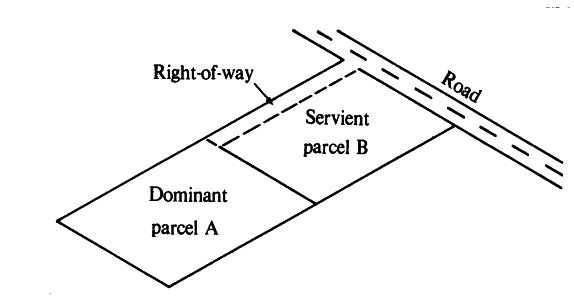Understanding Oklahoma Easement Laws: Legal Guide
Easements are an important aspect of property law in Oklahoma. They allow one party to use another person’s land for a specific purpose. Understanding these laws can help property owners navigate their rights and responsibilities. This legal guide will cover different types of easements, how to create them, and more. By the end, you’ll have a clearer picture of how easements work in Oklahoma and how they might affect you.
Types of Easements Recognized in Oklahoma

In Oklahoma, several types of easements exist, each serving different purposes. Here are the most common ones:
- Express Easement: Created through a written agreement between parties. This is the most straightforward type.
- Implied Easement: Established by actions or circumstances rather than a written document. For instance, if a property owner uses a path across a neighbor’s land for years, they might gain an implied easement.
- Prescriptive Easement: Gained through continuous, open, and notorious use of someone else’s property without permission over a specific period, usually 10 years in Oklahoma.
- Utility Easement: Granted to utility companies to install and maintain essential services like electricity, water, and sewer lines.
- Conservation Easement: Designed to protect natural resources and limit development on a property.
Understanding these types can help you determine which one applies to your situation.
How to Create an Easement in Oklahoma
Creating an easement in Oklahoma involves several steps, whether you’re the property owner or the person seeking to use the land. Here’s a simple process to follow:
- Identify the Purpose: Clearly define why you need the easement. Is it for access, utilities, or something else?
- Negotiate Terms: Discuss the terms with the property owner. This includes the duration, maintenance responsibilities, and any restrictions.
- Draft a Written Agreement: It’s crucial to have a written document that outlines all terms. This helps avoid future disputes. Consider including:
- Legal description of the property
- Specific rights granted
- Duration of the easement
- Responsibilities for maintenance
- Sign the Agreement: Both parties should sign the document. Consider having witnesses or a notary public present for added legal protection.
- Record the Easement: File the agreement with the county clerk’s office to make it legally binding and public.
Following these steps ensures that the easement is legally sound and protects the interests of both parties involved.
Rights and Responsibilities of Easement Holders
Easement holders have specific rights and responsibilities that are crucial to understand. If you hold an easement, you have the right to use the land for the purpose specified in your agreement. However, this right comes with certain duties. Here’s a closer look:
- Right to Use: You can access the property as agreed, whether it’s for utility lines, a driveway, or another purpose.
- Maintenance Responsibilities: Depending on your agreement, you might be responsible for maintaining the easement area. This includes keeping paths clear and ensuring that any structures related to the easement are in good condition.
- Respect the Property: While you have rights to use the easement, it’s essential to respect the property owner’s rights. Avoid any use beyond what is specified in the easement agreement.
- Notifying the Property Owner: If there are any issues, such as repairs needed for utility lines, you should inform the property owner promptly.
Understanding these rights and responsibilities will help both parties maintain a good relationship and avoid disputes in the future.
Disputes Over Easements in Oklahoma
Disputes over easements can arise for various reasons, from misunderstandings to violations of the easement terms. Here are some common sources of conflict and how they can be resolved:
- Misinterpretation of Terms: If the language in the easement agreement is unclear, it can lead to disagreements about what is allowed. Clear communication is key here.
- Obstruction of Access: Sometimes, property owners may block access to the easement area. This can lead to frustration for the easement holder.
- Changes in Use: If either party wants to change the way the easement is used, it can lead to disputes. Both parties should discuss any proposed changes openly.
To resolve disputes, it’s often best to start with a friendly conversation. If that doesn’t work, mediation or legal advice may be necessary. Courts in Oklahoma can also provide guidance on easement disputes, ensuring that the terms of the easement are enforced fairly.
Termination of Easements in Oklahoma
Understanding how easements can be terminated is just as important as knowing how to create them. There are several ways an easement can end in Oklahoma:
- Mutual Agreement: Both parties can agree to terminate the easement. This should always be documented in writing.
- Expiration of Terms: If the easement was created for a specific duration, it automatically ends once that time frame is completed.
- Non-Use: If an easement holder does not use the easement for a specified period, typically five years, it can be terminated, as this may indicate that it is no longer needed.
- Change of Circumstances: Significant changes, such as the sale of the property or changes in land use, can also lead to termination if both parties agree.
- Legal Action: In some cases, a court may determine that an easement should be terminated due to misuse or violations of the terms.
It’s essential for both property owners and easement holders to document any changes formally to avoid future disputes.
Legal Process for Challenging Easements
If you find yourself in a situation where you need to challenge an easement, understanding the legal process is crucial. Challenging an easement means you are questioning its validity or how it is being used. Here’s a breakdown of the steps involved:
- Gather Evidence: Collect all relevant documents related to the easement. This includes the easement agreement, any correspondence between parties, and evidence of how the easement is being used.
- Consult an Attorney: Seeking legal advice is essential. An attorney who specializes in property law can guide you through the process and help determine the strength of your case.
- Negotiate with the Other Party: Before taking legal action, consider discussing your concerns with the easement holder. Sometimes, a simple conversation can lead to a resolution without involving the court.
- File a Lawsuit: If negotiations fail, you may need to file a lawsuit in your local court. This involves submitting a complaint outlining your reasons for challenging the easement and any evidence you have.
- Attend Court Hearings: Be prepared to present your case in court. This may involve providing witness testimony and further evidence. The judge will then make a ruling based on the presented information.
Challenging an easement can be complex, but knowing these steps can make the process more manageable. Always keep in mind that having legal representation can significantly enhance your chances of a favorable outcome.
Frequently Asked Questions About Oklahoma Easement Laws
When it comes to easement laws in Oklahoma, many people have questions. Here are some of the most frequently asked questions:
- What is an easement? An easement is a legal right to use someone else’s property for a specific purpose, like accessing a road or utilities.
- How long does an easement last? The duration of an easement depends on how it was created. It can be temporary or permanent, based on the agreement.
- Can I sell my property with an easement? Yes, you can sell your property with an easement. However, it’s essential to disclose this to potential buyers.
- What happens if I violate the terms of an easement? Violating easement terms can lead to legal disputes. The easement holder may seek to enforce their rights through legal action.
- Can easements be modified or terminated? Yes, easements can be modified or terminated if both parties agree, or if certain conditions are met, such as non-use.
These FAQs can help clarify some common concerns regarding easement laws in Oklahoma. If you have more specific questions, consulting with a property attorney is always a good idea.
Conclusion on Understanding Easement Laws in Oklahoma
Understanding easement laws in Oklahoma is vital for both property owners and easement holders. Easements can significantly impact property rights and responsibilities, so knowing your rights is essential. Throughout this guide, we’ve discussed the different types of easements, the rights and responsibilities associated with them, how to challenge easements legally, and common questions that arise.
By grasping these concepts, you can better navigate the complexities of property law in Oklahoma. Whether you’re creating, using, or challenging an easement, being informed will help you protect your interests and maintain good relationships with neighboring property owners.
Remember, when in doubt, consulting with a legal professional can provide clarity and guidance tailored to your situation. With the right knowledge and support, you can confidently handle any issues related to easements.


